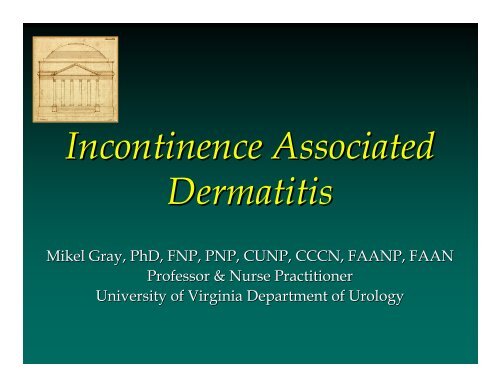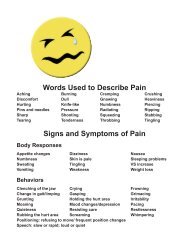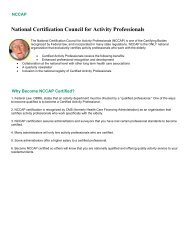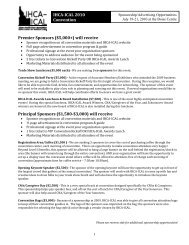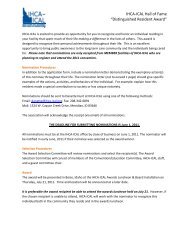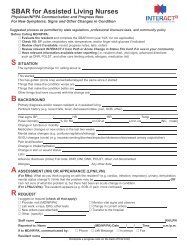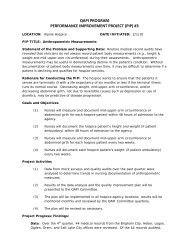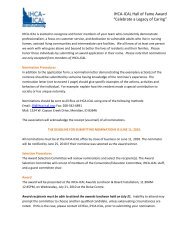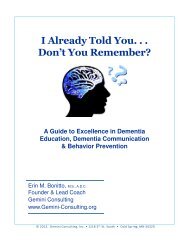Incontinence Associated Dermatitis
Incontinence Associated Dermatitis
Incontinence Associated Dermatitis
Create successful ePaper yourself
Turn your PDF publications into a flip-book with our unique Google optimized e-Paper software.
<strong>Incontinence</strong> <strong>Associated</strong><br />
<strong>Dermatitis</strong><br />
Mikel Gray, PhD, FNP, PNP, CUNP, CCCN, FAANP, FAAN<br />
Professor & Nurse Practitioner<br />
University of Virginia Department of Urology
Functions of the Skin<br />
Thermoregulation<br />
Sensory organ/<br />
communication<br />
Immune functions; acts as a<br />
first line of defense<br />
Vitamin D metabolism<br />
Barrier against toxins in<br />
external environment and<br />
against fluid & electrolyte<br />
loss from internal<br />
environment<br />
Burns T et al. Textbook of Dermatology, 2004. Mass: Blackwell Science.<br />
Figure: Verdier-Sevrain<br />
S, Bonte F. Journal of Cosmetic Dermatology 2007; 6:75.
Barrier Function: The Bricks<br />
Corneocytes (keratinocytes)<br />
– Anucleated cells filled with<br />
keratin & other molecules created<br />
by breakdown of filaggrin<br />
– Collectively referred to as natural<br />
moisturizing factor (NMF)<br />
– Surrounded by cornified<br />
envelope (corneodesmosomes(<br />
corneodesmosomes)<br />
that degrade as they move to<br />
surface of skin<br />
– 20% content is H 2 0<br />
Verdier-Sevrain<br />
S, Bonte F. J Cosmetic Dermatology 2007; 6:75.<br />
Gray M. American Journal of Clinical Dermatology 2010; 11(3): 201.<br />
Figure:<br />
http://www.bioskinregeneration.com/wrinkles/skin.j<br />
pg
Moisture Barrier:<br />
Natural Moisturizing Factor (NMF)<br />
NMF contains various hygroscopic molecules 1 :<br />
– Amino acids 40%<br />
– pyrrolidone carboxylic acid 12%<br />
– Lactate 12%<br />
– Urea 7%<br />
NMF levels ↓ by:<br />
– Repeated washing with soaps or detergents 2<br />
– Low humidity (
Skin’s s Moisture Barrier:<br />
The Mortar (Lipid Matrix)<br />
Primary components 1 :<br />
– Ceramides 50%<br />
– Cholesterol 23%<br />
– Free fatty acids 15%<br />
– Organized in lamellar arrangement as bi-layers with<br />
water; stores water needed for adequate hydration and<br />
slows water passage<br />
Lipid Matrix ↓ by:<br />
– Age 2<br />
– Seasonal effects 1<br />
– Atopy 2<br />
1. Verdier-Sevrain<br />
S, Bonte F. Journal of Cosmetic Dermatology 2007; 6:75.<br />
2. Rogers J et al. Archives in Dermatologic Resarch 1996; 288: 756.<br />
3. Chamlin SL et al. Archives in Dermatology 2001; 137: 1110.
Moisture Barrier:<br />
Additional Factors<br />
Aquaglyceroporin AQP3 1<br />
– Membrane protein that forms water channels across<br />
cell facilitating transport of water, urea, glycerol<br />
within epidermis but preventing excessive loss via SC<br />
– Expressed from the granulosum to just below the SC<br />
Tight Membrane Junctions 2<br />
– Water gradient steepest at junction or stratum<br />
corneum and stratum granulosum<br />
– TMJ comprises transmembrane proteins that control<br />
skin permeability<br />
1. Verkman AS, Mitra American J Physiology Renal Phys 2000; 278: F13.<br />
2. Madara JL. Annual Review of Physiology 1998; 60: 143.
Moisture Barrier:<br />
Vulnerable at the<br />
Extremes of Life<br />
Neonates: less efficient moisture barrier,<br />
especially in premature infants 1<br />
– More hydrophobic than older infants; result is<br />
dryer more brittle skin 2<br />
– TEWL ; ; skin capacitance <br />
Cornification begins about GW 20<br />
– Full-term skin contains 10-20 layers of SC, skin<br />
in premature baby has 2-32<br />
3 layers of SC<br />
– Ability to regenerate skin cells considerable<br />
1. Lund C et al. JOGNN 1999; 28(3): 241.<br />
2. Matsumoto T et al. Journal of Dermatology 2007; 34: 447.
Moisture Barrier<br />
Vulnerable at the Extremes of<br />
Life<br />
Aging Skin: gradual decline<br />
in barrier function<br />
– Thickness<br />
– NMF content<br />
– hydration<br />
– TEWL<br />
Comparatively slow to<br />
regenerate<br />
.
Water<br />
Adverse Effects of<br />
Urine on Skin<br />
– skin hardness, rendering it more susceptible<br />
to friction and erosion 1-3<br />
– Compromises barrier function of skin 4<br />
permeability to pathogenic species<br />
permeability to irritants in urine or stool<br />
– Effects exacerbated by presence of occlusive<br />
device such as warp around incontinence<br />
brief<br />
brief<br />
1. Berg W et al. Pediatric Dermatology 1986; 3: 102.<br />
2. Leyden JJ et al. Archives of Dermatology 1977; 113: 1678.<br />
3. Gray M. Journal of WOC Nursing 2004; 31(1 Suppl):S2-9.<br />
4. Zimmerer RE et al. Pediatric Dermatology 1986; 3: 95.
Ammonia<br />
Adverse Effects of<br />
Urine on Skin<br />
– From urine itself; ammonia also produced by<br />
conversion of urea in presence of certain bacteria,<br />
such as Corynebacterium and fungal species such<br />
as candida albicans 1-3<br />
– Especially with double UI & FI<br />
– No direct evidence ammonia damages intact skin;<br />
probably aggravates already compromised skin 1<br />
– Alkaline urine may provoke or exacerbate<br />
inflammation 2<br />
1. Leyden JJ et al. Archives of Dermatology 1977; 113: 1678.<br />
2. Atherton DJ Eur Academy Dermatology Venerology 2001; 15 (Supp1): 1.<br />
3. Berg W et al. Pediatric Dermatology 1986; 3: 102.
Adverse Effects of<br />
Stool on Skin<br />
Fecal enzymes<br />
– Protease & lipase potentially break down both<br />
principal elements of moisture barrier 1,2<br />
– In vivo evidence shows that exposure to<br />
digestive enzymes in human skin led to 3<br />
TEWL<br />
pH<br />
Visible Visible damage only when occlusion present<br />
Evidence Evidence of damage present after 12 days<br />
1. Atherton DJ Eur Academy Dermatology Venerology 2001; 15 (Supp1): 1.<br />
2. Gray M. Journal of WOC Nursing 2004; 31(1 Suppl):S2-9.<br />
3. Anderson PH et al. Contact <strong>Dermatitis</strong> 1994; 30(3): 152.
Pathophysiology<br />
Use of absorptive containment devices<br />
– Exacerbate overhydration by promoting<br />
perspiration & retaining urine and stool; with<br />
padding alone:<br />
TEWL TEWL increases 3-43<br />
4 fold within days<br />
COCO 2<br />
emission increases > 4 fold<br />
pH pH increases from 4.4 to 7.1 (without(<br />
incontinence)<br />
1. Grove GL et al. Clinical Problems in Dermatology 1998; 26:183<br />
2. Zimmerer RE et al. Pediatric Dermatology 1986; 3: 95.<br />
3. Zhai H et al. Skin Research & Technology 2002; 8:13.
IAD: Pathophysiology<br />
Urine/ Stool and Skin Flora<br />
– Flora of skin near groin usually<br />
colonized with staphylococcus<br />
epidermidis & diphtheroids such as<br />
Corynebacterium<br />
– Contains few gram negative bacilli<br />
– Candida albicans found in stool of infants<br />
with diaper dermatitis, but not infants<br />
without dermatitis<br />
Leyden JJ et al. Archives of Dermatology 1977; 113: 1678.
Beekman D et al. Journal of Advanced Nursing 2009; 65(6): 1141.
Definition:<br />
<strong>Incontinence</strong> <strong>Associated</strong> <strong>Dermatitis</strong><br />
(IAD)<br />
Irritation and inflammation<br />
associated with exposure to stool<br />
or urine<br />
Often accompanied by erosion of<br />
the skin<br />
Sometimes accompanied by<br />
secondary cutaneous infection<br />
(ie: candidiasis)<br />
Etiology and pathophysiology<br />
distinct from pressure ulceration<br />
Photograph courtesy Linda<br />
Bohacek
IAD as One Form of<br />
Moisture <strong>Associated</strong> Skin Damage (MASD)<br />
– Intertrigo: : inflammation in skin folds related to<br />
perspiration, friction and bacterial/ fungal<br />
bioburden<br />
– Periwound maceration: : skin breakdown from<br />
wound exudate, related to volume,<br />
constituents or exudate & bacterial bioburden<br />
– IAD: : urine, stool, containment device,<br />
secondary cutaneous infection –fungal or<br />
bacterial<br />
1. Gray M et al. Journal of Wound, Ostomy & Continence Nursing 2007; 2<br />
34(2):134.
Prevalence in Acute Care<br />
976<br />
Total number of<br />
patients surveyed<br />
35% had<br />
Foley catheter<br />
(deemed continent)<br />
20.3% (198)<br />
prevalence of<br />
incontinence<br />
urine or stool<br />
• 27% had IAD<br />
• 33% had a pressure<br />
ulcer<br />
• 18% had a probable<br />
fungal Infection<br />
21% had more than 1 type of injury<br />
Junkin J, Selekof J. IAD prevalence in acute care. WOCN National Conference, June 2006<br />
Minneapolis, MN.
Prevalence in Acute Care<br />
N = 608<br />
33% had<br />
Foley catheter<br />
(deemed continent)<br />
19.7% (120)<br />
prevalence of<br />
incontinence<br />
urine or stool<br />
• 42.5% perineal skin injury<br />
• 20% had IAD<br />
• 21.7% had PU<br />
• 10% had a probable<br />
fungal Infection<br />
Junkin J, Selekof J. Journal Wound, Ostomy & Continence Nursing 2007; 34(3): 260.<br />
.
Prevalence & Incidence<br />
in Critical Care Setting<br />
95% of 44 ICU patients with incontinence<br />
(n=44) 1<br />
MDS mined data suggests at least 5.7%<br />
prevalence from 10, 217 residents in 31 states 2<br />
3.4% incidence in 981 residents on IAD<br />
prevention program (over 14 days)<br />
Median (range) time to onset 13 days<br />
39% still had IAD after 2 weeks<br />
1. Peterson, AACN NTI abstract, 2007.<br />
2. Bliss DZ et al. Nursing Research 2006; 55(4): 243.
Etiology: Pressure Ulcers<br />
Pressure<br />
Shear<br />
Pressure + Shear<br />
Histopathologic Analysis of PU: ischemia 1<br />
1. Houwing RH et al. SKINmed 2007; 6(3): 113.
Etiology: IAD<br />
Histopathologic Analysis of IAD: inflammation 1<br />
1. Houwing RH et al.<br />
SKINmed 2007; 6(3): 113.
IAD & Pressure Ulcers<br />
Most experts believe that IAD impairs skin’s<br />
tolerance for pressure/ shear<br />
Ongoing debate & controversy reflects lack of<br />
knowledge of underlying mechanisms…in in one<br />
study subepithelial moisture differentiated<br />
erythema and stage I PU; higher SEM predicted<br />
greater likelihood of erythema/stage I PU 1<br />
FI and double incontinence strongly associated<br />
with PU risk, mixed evidence concerning UI<br />
alone 2-6<br />
1. Jensen BB. Journal of Wound, Ostomy and Continence Nursing, 20092<br />
(in pres).<br />
2. Maklebust J & Magnan MA Advances in Wound Care 1994; 7(6): 25.<br />
3. Gunninberg L. Journal of Wound Care 2004; 13(7): 286.<br />
4. Fader M et al. Journal of Clinical Nursing 2003; 12(3):374.<br />
5. Berlowitz DR et al. Journal of the American Geriatrics Society 2001; 49(7):866<br />
7):866-71. 71.<br />
6. Narayan S et al. Jounal of WOCN 2005; 32(3): 163.
IAD: Screening begins with CNA<br />
or Non-professional care provider
IAD:<br />
Diagnosis<br />
Relies solely on<br />
inspection<br />
– Inflammation (bright<br />
red) in persons with<br />
light skin tones<br />
– IAD located in skin fold<br />
or underneath<br />
containment device,<br />
borders are poorly<br />
demarcated & irregular<br />
– Surface of skin may<br />
“glisten” owing to<br />
serous exudate
IAD: Diagnosis in persons with<br />
Darker Skin Tones<br />
Inflammation not readily<br />
apparent (ie: not bright<br />
red); often presents as<br />
area of<br />
hyperpigmentation or<br />
subtle red tone<br />
Hypopigmented areas<br />
with chronic<br />
inflammation<br />
Pattern of skin damage<br />
does not vary
IAD: Diagnosis<br />
Inspect Skin Folds<br />
– Opposing skin surfaces trap<br />
& harbor moisture<br />
– Warm moist environment<br />
encourages bacterial and<br />
fungal colonization,<br />
overgrowth and infection<br />
– Friction occurs as skin folds<br />
rub against one another
IAD: Diagnosis<br />
Assess for skin<br />
erosion<br />
– Partial thickness<br />
erosion occurs with<br />
IAD<br />
– Necrotic tissue:<br />
eschar or slough, full<br />
thickness damage<br />
indicates pressure<br />
ulceration
IAD: Diagnosis<br />
Look for secondary<br />
cutaneous infection,<br />
especially candidiasis<br />
– Opportunistic infection with<br />
candida albicans<br />
– Thrives in warm, moist<br />
environment & damages<br />
stratum corneum<br />
– Seen in 18% of one group of<br />
976 acute care inpatients 1<br />
Junkin J, Selekof J. IAD prevalence in acute care. WOCN National l Conference, June 2006 Minneapolis, MN.
IAD: Diagnosis<br />
Suspect PU when wound<br />
is<br />
– Over bony prominence<br />
– Full thickness<br />
– Necrotic tissue is present<br />
– Skin is dark to purplish<br />
red<br />
Images: http://www.lhsc.on.ca/wound/p_chart.htm
Differentiate IAD from<br />
Pressure Ulceration<br />
Gray M et al. Journal of Wound, Ostomy and Continence Nursing 2007; 07; 34(2): 134.
IAD and its Severity<br />
Instrument<br />
Designed and validated by WOC nurses and<br />
their faculty<br />
2 WOC nurses established initial face validity<br />
Content and criterion validity via 9 WOC nurses<br />
in North Central Region of WOCN<br />
Interrater reliability via 247 WOC nurses<br />
attending 2007 National Conference<br />
Descriptive, ranks severity allowing longitudinal<br />
assessment; responsiveness has not yet been<br />
tested<br />
Borchert K et al. Journal of Wound, Ostomy and Continence Nursing 2010; 37(5): 527.
IAD and its Severity<br />
Instrument<br />
Borchert K et al. Journal of Wound, Ostomy and Continence Nursing 2010; 37(5): 527.
IAD and its Severity<br />
Instrument<br />
Borchert K et al. Journal of Wound, Ostomy and Continence Nursing 2010; 37(5): 527.
IAD and its Severity<br />
Instrument<br />
Borchert K et al. Journal of Wound, Ostomy and Continence Nursing 2010; 37(5): 527.
Clinical Evidence: How do we<br />
Prevent and Treat IAD?<br />
Structured skin care<br />
regimen based on<br />
available evidence and<br />
followed routinely<br />
Lyder, Journal of Enterostomal Therapy Nursing 1992<br />
Hunter et al., Journal of Wound, Ostomy and Continence Nursing 20032<br />
Zehrer et al., OWM 2004<br />
Bale et al., J Tissue Viability 2004<br />
Bliss, et al., Journal of Wound, Ostomy and Continence Nursing 20062
IAD: Prevention & Treatment
IAD: Cleanse<br />
When frequent bathing necessary, current<br />
evidence suggests….<br />
– Gentle cleansing: NO scrubbing 1,2<br />
– Select a cleanser with pH close to acid mantle of skin<br />
– Select product that minimizes potential irritants,<br />
scents, etc.<br />
– Towel drying has been found to compromise<br />
moisture barrier, consider no-rinse formulation for<br />
frequent bathing 2<br />
1. Gray M et al. Journal of Wound, Ostomy & Continence Nursing 2007; 2<br />
34(2):134.<br />
2. Voegeli D. Journal of Wound, Ostomy & Continence Nursing 2008; ; 35(1).
Moisturize<br />
Three categories<br />
– Humectants attract water to the skin<br />
– Emollients replace lipids to stratum corneum;<br />
designed to smooth skin surface<br />
– Occlusives act to protect skin from exposure<br />
to moisture and potential irritants; vary in<br />
their ability to maintain skin hydration<br />
– Some prefer emollient based on clinical<br />
considerations, no research available to verify<br />
or refute
Protect<br />
Skin Protectants should<br />
– Act as a “moisture barrier”, , protecting skin from<br />
deleterious effects of exposure to irritants and<br />
excess moisture<br />
– Maintain hydration and favorable skin’s s normal<br />
transepidermal water loss (TEWL)<br />
– Avoid maceration when left on for prolonged<br />
period of time<br />
– Options<br />
Ointment based skin protectants<br />
Liquid acrylates (marketed as a skin barrier)<br />
Gray M. Skin Protectants in the Treatment of Irritant <strong>Dermatitis</strong> In: Sek CK. Advances in Wound<br />
Care, Volume 1. New Rochelle, NY: Mary Ann Liebert, , Inc.
Protect<br />
Ointment based skin<br />
protectants<br />
– Petrolatum: : blend of<br />
castor seed oil &<br />
hydrogenated castor<br />
oil<br />
– Dimethicone: : silicone<br />
based oil<br />
– Zinc Oxide: : white<br />
powder, mixed with<br />
cream or ointment<br />
base
Clinical Evidence<br />
Petrolatum<br />
– Good protection against irritant<br />
– Avoided maceration<br />
– Modest skin hydration<br />
Dimethicone<br />
– Variable protection against irritant<br />
– Modest protection against maceration<br />
– Good skin hydration<br />
Zinc Oxide<br />
– Good protection against irritant<br />
– Did not avoid maceration<br />
– Poor skin hydration<br />
Hoggarth A et al. OWM 2005; 51(12): 30.
Protect<br />
Skin barriers (polymer acrylate)<br />
– Non-alcohol preferred<br />
Less pain<br />
Less drying<br />
No different when compared to ointment based<br />
skin protectants in one robust RCT (powered for<br />
economic rather than efficacy outcomes)<br />
Bliss DZ et al. Journal of Wound, Ostomy & Continence Nursing 2009; 09; 35 (2).
Cleanse, Moisturize & Protect:<br />
Single Step Approach<br />
Disposable Bathing<br />
Cloth: : Cleanses &<br />
moisturizes<br />
Shield Cloths: : Tailored<br />
cloths, cleanse<br />
(chlorhexidine<br />
gluconate), moisturize<br />
(glycerine, aloe),<br />
protect (3%<br />
dimethicone)
Hospital<br />
vs.<br />
Washcloth Disposable<br />
Washcloth
Preventive Skin Care<br />
Typical Protocol<br />
– Routine daily cleansing &<br />
moisturization for all<br />
patients<br />
– For Incontinent and High<br />
Risk Patients<br />
Cleanse, Cleanse, moisturize &<br />
protect daily and after<br />
each major incontinent<br />
episode
IAD: Treatment<br />
Establish or continue structured<br />
program based on “cleanse,<br />
moisturize & protect”, , consider<br />
changing skin protectant<br />
Minimize exposure to irritants<br />
(Aggressively manage UI or FI)<br />
Treat secondary cutaneous<br />
infections<br />
Allow skin to heal or apply<br />
protectant with active ingredients<br />
designed to promote healing
IAD: What about<br />
Dressings<br />
Topical Dressings<br />
– Hydrocolloids<br />
– Thin film dressings<br />
Act as barrier to urine & stool<br />
Promote moist environment<br />
for wound healing<br />
Can be combined with topical<br />
treatments
Dressings:<br />
Practical Concerns<br />
Topical Dressings<br />
– Maintaining adherence<br />
significant challenge<br />
– Skin surfaces complex<br />
– Borders often roll when<br />
ointments or<br />
moisturizing products<br />
have been applied<br />
– Undermining of urine<br />
or stool may occur
IAD Treatment<br />
Aluminum sulphate or acetate (Burow’s<br />
Solution) with Stomahesive powder:<br />
– Applied as compress; causes protein<br />
precipitation & has antimicrobial properties<br />
– Exerts drying & soothing effect; followed by<br />
application of moisture barrier<br />
– Often used when dermatitis complicated by<br />
extensive erosion and serous exudate
IAD: Treatment<br />
BCT Agents<br />
– BCT Ointment (Xenaderm)<br />
Balsam Peru, Castor Oil, Trypsin in<br />
ointment base<br />
Applied to dermatitis twice daily or with<br />
major cleansing<br />
Goal is to combine skin protectant<br />
with active ingredients that promote<br />
wound healing
IAD Treatment:<br />
Secondary Complications<br />
Candidiasis<br />
– Topical antifungals are effective for the<br />
treatment of cutaneous infections<br />
– Effective agents include the polyene<br />
antibiotics, azoles and the allylamines 1<br />
– Resistance to antifungals is emerging, careful<br />
monitoring of research literature is essential<br />
1. Evans E & Gray M, Journal of Wound, Ostomy & Continence Nursing 2003; ,30(1).
Conclusion<br />
IAD is a prevalent and clinically relevant<br />
condition,<br />
Relationship to PU risk poorly understood,<br />
etiology appears distinct, some<br />
pathophysiologic mechanisms shared<br />
Structured skin regimen key to prevent &<br />
treat<br />
Principles of skin regimen: cleanse,<br />
moisturize & protect


